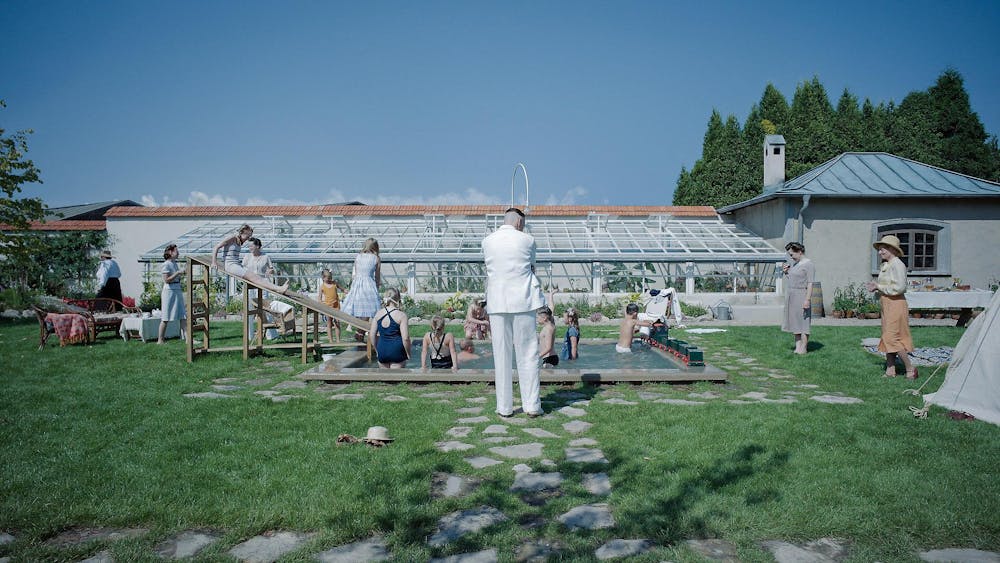Holocaust cinema has always grappled with the seemingly impossible question of whether historical atrocities can be rightfully represented on screen. And, is it even worth trying to artistically recreate such a crime against humanity? Jonathan Glazer’s 2023 film “The Zone of Interest,” loosely based on Martin Amis’ 2014 book of the same name, seems to do away with the emotional storytelling that its predecessors have been defined by. Uniquely committed to offering a passive view of the evils of the Holocaust, the film delivers a perspective of the time period that, in its deliberate ignorance, takes its genre to a new level of sinister.
“The Zone of Interest” is made horrific by what it doesn’t show. The film opens with an empty black screen stretched out through several minutes while the audience is flooded by auditory cues without any visual material. An ominous score soon elusively blends into a lush soundscape of chirping birds and flowing water. When the film’s first scene properly appears on screen — a family enjoying an idyllic picnic by the riverside — the feeling is akin to waking up from a disorienting dream. Despite this return to “normalcy,” the film never lets go of its introduction’s unsettling aura.
The film soon turns its focus to a picturesque villa where Rudolf and Hedwig Höss (Christian Friedel and Sandra Hüller) have built their dream home — fit with five children, a large vegetable garden and a swimming pool. Pastel colors and intricate set pieces, combined with long shots that show off the household, present the characters like dolls wandering around a well-constructed utopia. Instead of exploring the characters’ personal motivations or desires, the film keeps its distance, using an unbiased lens to follow their actions within a bubble of banality.
However, cracks in this fantasy slowly reveal themselves, some more subtly than others. A long shot of a man wheeling a cart through the yard appears ordinary at first, until one notices the barbed wire strung across the tall garden wall and the decrepit brick chimneys and roofs just outside it. A scene where Hedwig tries on a new coat is momentarily interrupted by what sounds like two gunshots in the distance. Pairing these moments with details like the Nazi insignia on Rudolf’s military uniform and short-lived conversations mentioning crematoriums, it soon becomes clear that Rudolf is a commandant of Auschwitz, and that his family resides in close proximity to the infamous site.
Once these key facts settle in, the film seems to respond by amplifying the degree to which it toes around the periphery of blatant violence. With almost the entirety of its scenes set in the confined Höss household, “The Zone of Interest” relies heavily on sound design and framing to allude to the ongoing brutality. Flames and smoke are often present in the distant background, alluding to the burning of corpses without ever showing the carnage. Ordinary conversations and clatter are mixed with gunshots and the screams of prisoners in the distance; meticulous sound design causes the noises from the hellish site next door to be treated as a background hum that can be easily tuned out.
In a more extreme technical move, Glazer notably makes use of a black and white thermal-imaging camera to show several scenes where a young girl leaves behind food for the Jews imprisoned in the camp to find. A threatening score accompanies these moments, shocking viewers out of the indifferent haze that the film has set as its “status quo.” These scenes are jarring in both a visual and auditory sense, emphasizing how any instances that occur outside of the Nazis’ manufactured obliviousness are literally obscured from clear view.
Focused on exploring stylistic devices to refer to an evil that never fully shows itself, “The Zone of Interest” has a significant lack of plot. The biggest, and possibly only, narrative event in the film is Rudolf’s promotion to deputy inspector and relocation to Oranienburg, leaving his family behind in Auschwitz. Even so, this plot point is also treated with a disturbing tone of nonchalance, only serving to emphasize how natural Hedwig finds the life she enjoys next to a concentration camp. At times the film is disadvantaged by its decision to merely observe rather than incite action — one could even argue that its message may have been more powerful as a short film. But it is moments like these that showcase how in being a bystander to its own narrative, “The Zone of Interest” allows the evils within its characters to fester and reveal themselves.
Despite being a narrative set on a period so saturated with death and suffering, Glazer’s Holocaust film is characterized by its hollowness. Memorable in what it refrains from showing rather than what it actually depicts, “The Zone of Interest” draws out the ghostly outlines of the everyday lives that lay dormant behind some of the worst crimes in history.
Isabel Hahn is an Arts & Culture editor who concentrates in English and Behavioral Decision Sciences. In her free time, she enjoys watching movies, reading, and journaling.





